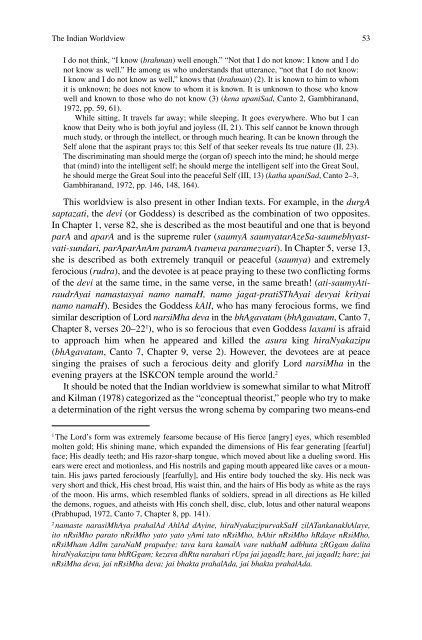Spirituality and Indian Psychology: Lessons from ... - Mandhata Global
Spirituality and Indian Psychology: Lessons from ... - Mandhata Global
Spirituality and Indian Psychology: Lessons from ... - Mandhata Global
Create successful ePaper yourself
Turn your PDF publications into a flip-book with our unique Google optimized e-Paper software.
The <strong>Indian</strong> Worldview<br />
I do not think, “I know (brahman) well enough.” “Not that I do not know: I know <strong>and</strong> I do<br />
not know as well.” He among us who underst<strong>and</strong>s that utterance, “not that I do not know:<br />
I know <strong>and</strong> I do not know as well,” knows that (brahman) (2). It is known to him to whom<br />
it is unknown; he does not know to whom it is known. It is unknown to those who know<br />
well <strong>and</strong> known to those who do not know (3) (kena upaniSad, Canto 2, Gambhiran<strong>and</strong>,<br />
1972, pp. 59, 61).<br />
While sitting, It travels far away; while sleeping, It goes everywhere. Who but I can<br />
know that Deity who is both joyful <strong>and</strong> joyless (II, 21). This self cannot be known through<br />
much study, or through the intellect, or through much hearing. It can be known through the<br />
Self alone that the aspirant prays to; this Self of that seeker reveals Its true nature (II, 23).<br />
The discriminating man should merge the (organ of) speech into the mind; he should merge<br />
that (mind) into the intelligent self; he should merge the intelligent self into the Great Soul,<br />
he should merge the Great Soul into the peaceful Self (III, 13) (katha upaniSad, Canto 2–3,<br />
Gambhiran<strong>and</strong>, 1972, pp. 146, 148, 164).<br />
This worldview is also present in other <strong>Indian</strong> texts. For example, in the durgA<br />
saptazati, the devi (or Goddess) is described as the combination of two opposites.<br />
In Chapter 1, verse 82, she is described as the most beautiful <strong>and</strong> one that is beyond<br />
parA <strong>and</strong> aparA <strong>and</strong> is the supreme ruler (saumyA saumyatarAzeSa-saumebhyastvati-sundari,<br />
parAparAnAm paramA tvameva paramezvari). In Chapter 5, verse 13,<br />
she is described as both extremely tranquil or peaceful (saumya) <strong>and</strong> extremely<br />
ferocious (rudra), <strong>and</strong> the devotee is at peace praying to these two conflicting forms<br />
of the devi at the same time, in the same verse, in the same breath! (ati-saumyAtiraudrAyai<br />
namastasyai namo namaH, namo jagat-pratiSThAyai devyai krityai<br />
namo namaH). Besides the Goddess kAlI, who has many ferocious forms, we find<br />
similar description of Lord narsiMha deva in the bhAgavatam (bhAgavatam, Canto 7,<br />
Chapter 8, verses 20–22 1 ), who is so ferocious that even Goddess laxami is afraid<br />
to approach him when he appeared <strong>and</strong> killed the asura king hiraNyakazipu<br />
(bhAgavatam, Canto 7, Chapter 9, verse 2). However, the devotees are at peace<br />
singing the praises of such a ferocious deity <strong>and</strong> glorify Lord narsiMha in the<br />
evening prayers at the ISKCON temple around the world. 2<br />
It should be noted that the <strong>Indian</strong> worldview is somewhat similar to what Mitroff<br />
<strong>and</strong> Kilman (1978) categorized as the “conceptual theorist,” people who try to make<br />
a determination of the right versus the wrong schema by comparing two means-end<br />
1 The Lord’s form was extremely fearsome because of His fierce [angry] eyes, which resembled<br />
molten gold; His shining mane, which exp<strong>and</strong>ed the dimensions of His fear generating [fearful]<br />
face; His deadly teeth; <strong>and</strong> His razor-sharp tongue, which moved about like a dueling sword. His<br />
ears were erect <strong>and</strong> motionless, <strong>and</strong> His nostrils <strong>and</strong> gaping mouth appeared like caves or a mountain.<br />
His jaws parted ferociously [fearfully], <strong>and</strong> His entire body touched the sky. His neck was<br />
very short <strong>and</strong> thick, His chest broad, His waist thin, <strong>and</strong> the hairs of His body as white as the rays<br />
of the moon. His arms, which resembled flanks of soldiers, spread in all directions as He killed<br />
the demons, rogues, <strong>and</strong> atheists with His conch shell, disc, club, lotus <strong>and</strong> other natural weapons<br />
(Prabhupad, 1972, Canto 7, Chapter 8, pp. 141).<br />
2 namaste narasiMhAya prahalAd AhlAd dAyine, hiraNyakazipurvakSaH zilATankanakhAlaye,<br />
ito nRsiMho parato nRsiMho yato yato yAmi tato nRsiMho, bAhir nRsiMho hRdaye nRsiMho,<br />
nRsiMham AdIm zaraNaM prapadye; tava kara kamalA vare nakhaM adbhuta zRGgam dalita<br />
hiraNyakazipu tanu bhRGgam; kezava dhRta narahari rUpa jai jagadIz hare, jai jagadIz hare; jai<br />
nRsiMha deva, jai nRsiMha deva; jai bhakta prahalAda, jai bhakta prahalAda.<br />
53

















